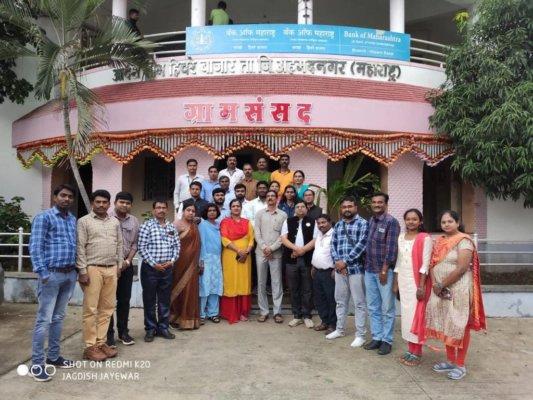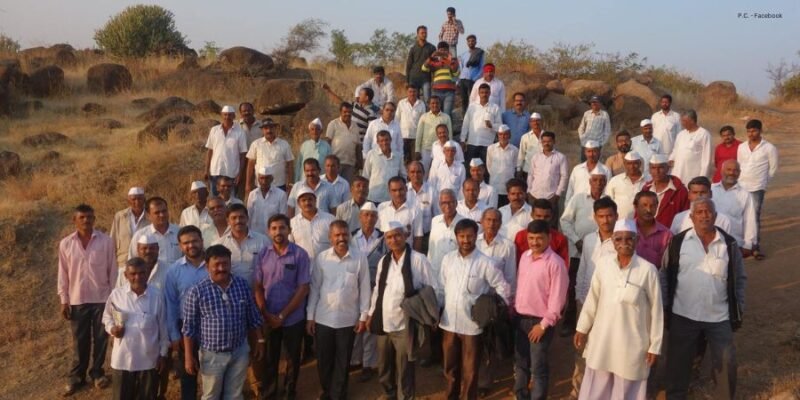Hiware Bazar is a hamlet deep lost in the rural area of Maharashtra. The Hiware Bazar was crime-mounded & extremely backwards four decades back, terribly impoverished, and mostly ignored by government authorities. Most families possessed land in the village, but they were unable to cultivate food to eat or sell due to continuous drought in the area. Most youngsters left the village at the age of 15 to hunt for jobs in adjacent cities.
However, in the 1990s, the community’s fortunes changed, and it became a rich village with approximately 60 billionaires, who are all farmers. Popatrao Baguji Pawar (the community leader) deserves credit for this ‘from poverty to kingship’ accomplishment since he irrevocably transformed the socioeconomic fabric of the hamlet.
Hiware Bazar and its success story
The story of Hiware Bazar village seems like a story straight from Bollywood but it’s an impressive reality. Hiware Bazar surely deserves to be a part of our Top 5 Indian Villages That The World Needs To Visit Right Now

65% of the population in India lives in villages, where agriculture is the main source of income. Farming, on the other hand, has been unproductive in some parts of India during a phase of late 70s & 80s because of drought, a shortage of direct market integration, high input prices, and poor market pricing. Just like many other villages in India farmers of Hiware Bazar had the same fate only until they decided to challenge it. Odanthurai: India’s Smart Village, is also something impressive to know about just like Hawari Bazar
Hiware Bazar is located in the drought-prone Ahmednagar district in Maharashtra and receives less than half the national normal rainfall each year. Agriculture was mostly rain-fed there, although locals had always produced enough to support themselves. Every family had cattle or goats, & dairy farming was the principal source of revenue.
However, the community had three severe droughts beginning in 1972, turning the soil barren, called ‘Banjar’ in the local language. Wells ran dry, forage for cattle vanished, and residents turned to a forest on neighbouring hills, taking down the trees for fuel to create liquor, for both sale and to relieve the agony as their livelihoods crumbled.
Alcohol manufacturing and selling became the principal source of revenue. Crime increased as a result. Villagers would also attack government officials, such as forestry inspectors who forbade livestock from grazing on the wooded slopes near Hiware Bazar. People would tie up the forest authorities to trees, and soon their village became a ‘punishment posting,’ where government officers, teachers, & health officials were only placed if they needed to be punished.

Hiware Bazar lost the majority of its natural resources by the 1980s. Only a small portion of the area could be farmed, the soil was depleted, and there wasn’t any power. People first fled the village, believing it was only a transitory situation. They eventually simply stayed away. Those who remained were forced to labour on farms or on building sites in neighbouring communities for pitiful salaries.
When contractors came searching for labour in Hiware Bazar, the people would fight over the positions and beat each other up as there were no jobs at all.
In reality, almost 90% of the population fled to cities in search of a better life. To stop the Hiware Bazar hamlet’s despair, the youth agreed to nominate a young village leader who could reverse the village’s direction.

But village Hiware Bazar saved itself from the atrocities of time and management but it was not an easy task it required years of hard work. Nobody understands this better than Popatrao Pawar, the Hiware Bazar village’s sarpanch who pioneered the village’s turnaround.
“It seemed unattainable when we first started, It’s paradise reclaimed for us.”
The concept of Hiware Bazar widely known as the “village of billionaires,” is now being practised in thousands of other villages all across India. The hamlet transformed itself into a national “model of development” by implementing effective watershed management, restoring natural resources, and shifting to more sustainable agriculture that is less water-intensive, all of which relied on citizen participation. Agriculture’s success has fueled improvement in other areas of Hiware Bazar, including healthcare and education.
When responsible citizens take responsibility for their duties, the country starts to bloom, when the youngest woman sarpanch from Haryana – Parveen Kaur, decided to bring in change she Got CCTV, a library, and solar lights to her village. similarly, Popatrao Pawar was overwhelmingly elected village leader (sarpanch) of Hiware Bazar in 1989, and thereafter the Hiware Bazar villagers had no time to look back since.
First and foremost, Pawar eliminated the threat of smoking & inebriation by closing all illegal liquor outlets in the hamlet, followed by a prohibition on the consumption of booze and cigarettes.
Because Hiware Bazar is located in a rain shadow and receives very little rainfall (below 15 ” per year), it became critical to supply its water demands. Pawar applied for a loan & began a rainwater collection and watershed management and conservation programme in the community to accomplish this. He created various water bodies with the help of the locals, including 32 stone bunds, 52 earthen bunds,check dams, & percolation tanks to retain rainwater, as well as thousands & lakhs of trees planted.

This watershed strategy aided the locals in irrigation and grain harvesting.Once only 90 wells in 1990, this little town now has around 294 wells. Within a few years, the level of water in the wells & other man-made structures surrounding the community began to rise, and farming returned to full swing, becoming the primary source of revenue for the people. In addition, the hamlet renounced the use of crops that were water-intensive in favour of growing vegetables, grains, flowers & fruits that use less water.
The locals also began focusing on cow rearing, which resulted in a rise in milk output, resulting in massive cash. In the 1990s, around 33 gallons of milk were supplied every day, & today, approximately 880 gallons of milk are produced per day. The hamlet learned to deal with every problem thrown their way, whether natural or man-made. Slowly and slowly, the hamlet grew and prospered, leading to reverse migration. In 1995, 168 of 182 households were classified as poor, but today, there are only just three families under the poverty line in Hiware Bazar.

Other notable achievements include: the Hiware Bazar village is immaculate, every home has a toilet, every house uses biogas. Schools and a healthcare system have been developed, electricity and water run throughout the village, three women serve on a 70-member panchayat (self-government framework), and every second daughter’s marriage and education expenses are incurred by the village itself—all of which are uncommon in the hundreds & thousands of villages in India. That is not all. More than 60% of the community’s youngsters are now studying medicine, and the hamlet has implemented family planning & HIV/AIDS prevention measures, in addition to various other health and cleanliness projects.
Furthermore, open defecation, and cigarette and alcohol usage are completely forbidden in the community of Hiware Bazar, as is deforestation, grazing, and irrigation tube wells. With every passing year, the hamlet thrives, and it has acquired a decent living level with wages nearly double those of other rural communities in India.
Pawar’s strong administration at Hiware Bazar, hard work, and devotion, together with local support and involvement, earned the village, the Maharashtra Government’s title of Ideal Village. India’s prime minister, Pm Modi, congratulated the village head & the inhabitants in a Mann Ki Baat radio speech in 2016. As a consequence of this achievement, Popatrao Pawar has now been chosen chairman of Maharashtra’s Model Village Programme, whose mission is to establish 100 comparable villages. And if more communities follow this example, there will a day when no one will be poor in the country.
Feature Image Facebook
If you like this story, then read another inspiring story about how Ngurang Meena sets up a free self-help roadside library to instill the habit of reading in children and adults.
If you know more inspirational stories about a person, company, new idea, or social initiative, and want us to write it on mad4india.com, share such information with us on Facebook and LinkedIn.





